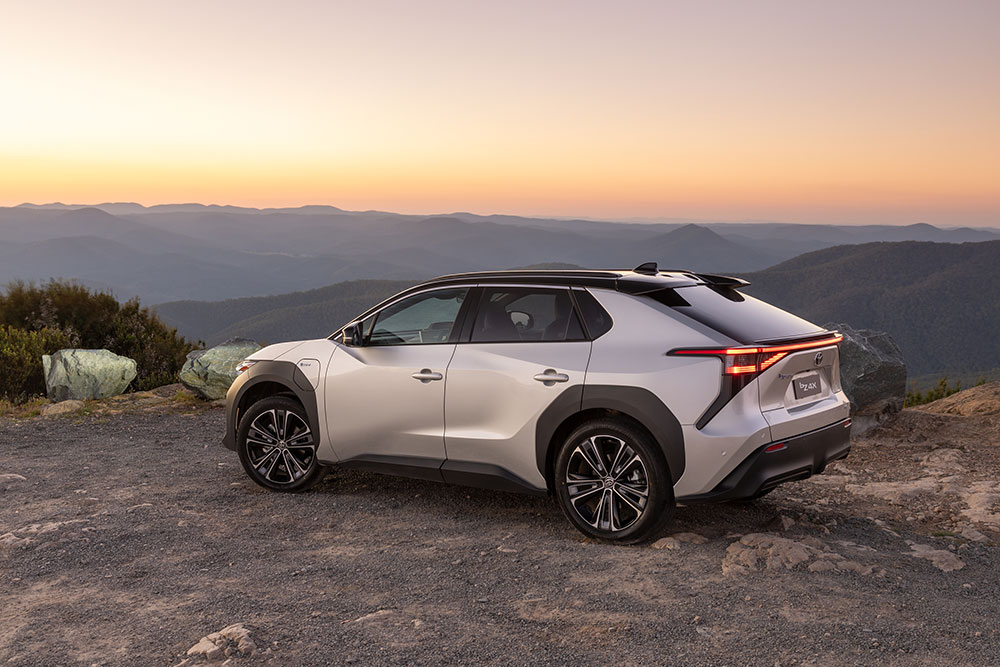Toyota bZ4X review
Long established as a global leader in the hybrid electric vehicle (HEV) space, industry giant Toyota has been conspicuously absent from the fully electric space until the recent launch of its all-new bZ4X.

After two decades of hybrid-electric vehicle dominance, Toyota Australia has at long last released its first full battery-electric vehicle, the typographically challenged bZ4X.
The new model arrives a decade after Tesla launched its first EV in Australia and some 18 months after the bZ4X was originally scheduled to launch.
A mid-sized SUV, the bZ4X is built on Toyota’s all-new e-TNGA dedicated skateboard architecture which integrates the battery and motor generator into the vehicle structure, providing extra rigidity and a low centre of gravity for stable driving dynamics.
Dimensionally, the bZ4X is similar in size to a RAV4, being 90mm longer, 5mm wider, 45mm lower, and riding on 2,850mm wheelbase.
The packaging benefits from its 160mm longer wheelbase and compact electric drivetrain combining to create generous passenger accommodation.
There are two variants of the stylish and contemporary-looking BEV available, dubbed simply bZ4X 2WD (front-wheel drive) and bZ4X AWD (all-wheel drive).
The former retails for $66,000, while the dual motor AWD tips the financial scales at a heftier $74,900 (MRLP).

As its name suggests, the FWD drives its front wheels only via an e-Axle that combines the 150kW/266Nm electric motor with an inverter in a single compact unit.
The twin-motor AWD places an 80kW e-Axle at either end for combined system outputs of 160kW/337Nm.
In both cases the battery fitted is a 71.4kWh lithium-ion unit that gives the 2WD a claimed range of 436km (WLTP) or 411km (WLTP) for the AWD with both versions able to accept DC charging rates of up to 150kW.
Toyota claims it rigorously tests each battery for twenty days before it is fitted to the vehicle to ensure there are no reliability issues.
Among its many efficiency measures designed to extra maximum efficiency from the battery, the bZ4X uses a heat-pump air-conditioning system that is claimed to be up to 30% more efficient than traditional air-conditioning systems.
On the styling front, the bZ4X is the first Toyota model in Australia to use the company’s new ‘hammerhead’ frontal design theme, where the bonnet surface continues to the nose and extends to each corner.
It’s a good-looking SUV from any angle, with just enough traces of Toyota DNA in its design to ensure it’s not confused for its technical doppelganger, the Subaru Solterra EV.
Let us do the work finding your next new car
Among its comprehensive equipment list, the bZ4X 2WD includes poly-ellipsoidal LED headlights, 20-inch alloy wheels, heated and auto power-folding side mirrors, power tailgate, and rear privacy glass. The AWD adds to this list a roof spoiler, fixed panoramic sunroof, roof rails and gloss black bonnet accents.
Inside, occupants of the entry-level model will find a contemporary-looking design characterised by an unusual fabric-covered dashboard, heated front seats clad in synthetic leather, eight-way adjustable electric driver’s seat, dual-zone climate control, smart entry and start, and a 12.3-inch touchscreen infotainment system equipped with wireless Android Auto and Apple CarPlay. Standard too, is Toyota’s Connected Services technology which provides internet-enabled information on the nearest charger locations, live traffic updates, and over-the-air updates when available.
The AWD adds a premium JBL audio system, 10W wireless phone charger, ventilated front seats, heated steering wheel, driver’s seat memory function and a kick sensor for the power tailgate.
Curiously, while there’s plenty of stowage in the cabin for drink bottles, wallets and the like, there’s no glovebox. Instead, occupants must make do with the lidded centre console bin and other areas around the centre console.
There’s ample interior room otherwise, particularly in the rear seats which benefit most from the longer wheelbase and the flat floor provided by the absence of a transmission tunnel hump.
When it comes to boot space, the 2WD model boasts 421 litres of cargo space with the AWD having a slightly lower 410 litres due to its extra motor.
This compares favourably with Toyota’s Corolla Cross small SUV but is less than the 542-litres offered by the RAV4.

There’s an inflator kit but no spare wheel beneath the cargo floor, even though Toyota claims the AWD model was developed with some level of off-road capability in mind.
In fact, Toyota says the bZ4X underwent development testing on the same off-road course used to test the next generation LandCruiser Prado.
The AWD’s off-road driving modes were developed in conjunction with Subaru and use that brand’s X-mode traction control system which includes selectable Snow/Dirt or Deep Snow/Mud modes, along with Crawl Control and Downhill Assist Control modes.
Coupled with a generous 212mm of ground clearance, plus good approach and departure angles, the bZ4X certainly has more capability than a regular passenger vehicle, and the ability to traverse moderately difficult terrain, if driven carefully and with the limitations of its low profile 20-inch tyres in mind.
On the safety front, the bZ4X achieved a five-star ANCAP rating with its standard safety features including a pre-collision warning system that in daylight can detect pedestrians, bicycles, motorbikes and vehicles, including at intersections.
Other safety systems on both models include emergency steering assist, lane trace assist, traffic sign recognition, active cruise control, and seven airbags, with the AWD adding blind-spot monitoring, safe exit assist, rear cross-traffic alert and panoramic view monitoring.
On the road, the bZ4X exhibits refined and pleasant driving manners. It’s not especially exhilarating in terms of pace or dynamic ability compared to other EVs, but is notable for its quietness, smoothness and responsiveness.
It’s clear that Toyota has spent plenty of its R&D budget on eliminating unnecessary wind and road noise that might otherwise have been shown up by the near-silent electric drivetrain.
The result is a cabin that’s ultra quiet on a smooth tarmac road with virtually no wind or road noise evident at 100km/h, although coarse chip bitumen does ruin the ambience somewhat.
The underlying suspension is fully independent, comprising MacPherson struts at the front and double wishbones at the rear, which combine well to soak up most road imperfections, while delivering confident and assured cornering. Among the few criticisms is the fact the steering weighting is on the light side, while the wheel itself is of a small diameter.
Retained or residual values of EVs has been in the news of late, with some studies indicating EVs are not holding their value as well as some internal combustion powered models, potentially due to concerns about battery longevity.
In part to address this, Toyota is offering the bZ4X as a full-service lease option through Toyota Finance Australia with the lease covering vehicle maintenance, tyres, roadside assistance, registration and insurance over a three-year period.
The company says the leasing option is designed to encourage those customers concerned about lower residual values to make the change to an EV, with the lease also allowing customers to include a home charger in the deal.

As a further incentive, customers who apply for a full-service lease option by 30 June and take delivery of their vehicle before the end of 2024 will receive a free JET Charge 7kW home charger with standard installation, or a subsidy towards a larger charging unit if they have three-phase power.
Lease customers will also receive an extra two years of complimentary Toyota Connected Services over and above the standard 12-month term.
Toyota says it expects the battery to retain at least 90% of its original capacity after 10 years, although the supplied battery warranty only covers the unit for up to 70% after eight years or 160,000km.
In summary, the bZ4X represents a solid first-up foray into the battery electric vehicle world for Toyota.
In both 2WD and AWD guises it’s priced competitively against equivalent models including the Hyundai Ioniq 5 and Tesla Model Y, as well as Subaru’s new Solterra which is AWD only.
While there are certainly more affordable EVs available, and others with superior range and performance, the fact the bZ4X is backed by one of the industry’s most respected brands will likely guarantee it a solid degree of success in the increasingly competitive EV space.
Toyota bZ4X key info
- Retail price: $66,000 - $74,900 (MRLP)
- Battery: 71.4kWh
- Motors: Single 150kW/266Nm, Dual 160kW/337Nm
- Range: 411km – 436km (WLTP)
- Safety: Five-star ANCAP rating (2022)
- For: Quiet and refined, high-quality finish, modest all-terrain ability.
- Against: No spare wheel, some rivals offer superior range.
Related topics
Things to note
The information in this article has been prepared for general information purposes only and is not intended as legal advice or specific advice to any particular person. Any advice contained in the document is general advice, not intended as legal advice or professional advice and does not take into account any person’s particular circumstances. Before acting on anything based on this advice you should consider its appropriateness to you, having regard to your objectives and needs.
Insurance Products (excluding Travel Insurance) are issued by RACQ Insurance Limited ABN 50 009 704 152 (RACQI) and arranged by its agent, RACQ Distribution Services Pty Ltd (RDS) ABN 35 116 361 650, AFSL 567130 and RDS' authorised representatives (including RACQ Operations Pty Ltd ABN 80 009 663 414, AR No. 234978 (RACQO). Conditions, limits and exclusions apply. RDS and RACQO are in the RACQ group of companies. One of the companies in the RACQ group of companies has a minority shareholding in RACQI.
RDS and RACQO have not taken your personal objectives, circumstances or needs into account when preparing advice regarding insurance products and you will need to consider whether the advice is appropriate for you. Read the Product Disclosure Statement (PDS) and any applicable Supplementary PDS before making a purchase decision on this product. You can also access our Target Market Determinations on this website. RDS receives a commission from RACQI for the policies it arranges. RACQO receives fees paid for services it provides to RDS. Further details about remuneration are available on request prior to purchasing.
Banking and loan products issued by Members Banking Group Limited ABN 83 087 651 054 AFSL/Australian credit licence 241195 trading as RACQ Bank. Terms, conditions, fees, charges and lending policies apply. This is general advice only and may not be right for you. This information does not take your personal objectives, circumstances or needs into account. Read the disclosure documents for your selected product or service, including the Financial Services Guide and the Terms and Conditions, and consider if appropriate for you before deciding.
Except for RACQ Bank, any RACQ entity referred to on this page is not an authorised deposit-taking institution for the purposes of the Banking Act 1959 (Cth). That entity’s obligations do not represent deposits or other liabilities of RACQ Bank. RACQ Bank does not guarantee or otherwise provide assurance in respect of the obligations of that entity, unless noted otherwise.
RACQ Bank subscribes to the Customer Owned Banking Code of Practice which establishes higher standards than the law requires. The Code reflects modern consumer expectations and developments in approaches to issues such as consumer vulnerability, guarantors, and supporting customers through financial hardship. Please read our Customer Owned Banking Code of Practice page for more information.
RACQ Operations Pty Ltd (ABN 80 009 663 414 AR 000234978) and Members Travel Group Pty Ltd (ABN 45 144 538 803 AR 000432492) are acting as an Authorised Representative of the issuer of the insurance, Tokio Marine & Nichido Fire Insurance Co., Ltd. (ABN 80 000 438 291 AFSL 246 548). Any advice set out above is general in nature only, and does not take into account your objectives, financial situation or needs. Before purchasing any travel products, please consider the RACQ Travel Insurance Product Disclosure Statement (PDS) and the Target Market Determinations (TMDs) that apply to these products. Whilst the PDS outlines the Terms and Conditions of these products, the TMDs outline the intended class of customers that comprise the target market for these travel products. This will allow you to consider which products best suit your objectives, financial situation and needs and consider the products appropriateness to your personal circumstances. TMDs also outline matters involving the distribution and the review of these products. The PDS, Supplementary PDS and TMDs for each travel product can be found here.

